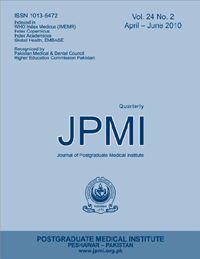TEMPERATURE MONITORING AND PERIOPERATIVE HEAT LOSS
Main Article Content
Abstract
Objectives: To assess the temperature fall at various stages in the perioperative period and identification
of contributing factors.
Material & Methods: This observational study was carried out at Blackpool Victoria Hospital, UK from
August 2005 – January 2006 on 32 patients undergoing major lower limb vascular surgery. Semistructured
data collection form was designed to record the time and tympanic temperature at different
stages in perioperative period and the warming methods used.
Results: A median fall of 0.1oC (0 - 0.5oC) in core temperature was recorded in ward and theatre reception
area. The median fall of temperature in the anaesthetic room was 0.3oC (0-.8oC). Patients (n=16) spending
more than ½ hour in the anaesthetic room had a significant (p=0.002) temperature drop recorded at 0.4oC
as compared to 0.2oC for those spending less than 30 minutes. During operation, a median fall of
temperature by 0.8oC (0.3 – 2.1oC) was recorded. Operations lasting for 21/ hours or more (n=16) resulted 2
in a 1oC temperature fall as against 0.5oC for the rest. Seven patients, in whom a warming mat was used,
had a temperature drop of 0.6oC compared to 0.35oC in patients who received warm touch. In the recovery
unit, 23 patients had a further drop of 0.3oC, while 9 patients who were actively warmed gained 0.6oC.
Conclusions: Significant heat loss occurs in the anaesthetic room relevant to the length of time consumed
in anaesthetising the patient. Furthermore active warming measures in the perioperative period have a
positive impact on maintaining core temperature.
of contributing factors.
Material & Methods: This observational study was carried out at Blackpool Victoria Hospital, UK from
August 2005 – January 2006 on 32 patients undergoing major lower limb vascular surgery. Semistructured
data collection form was designed to record the time and tympanic temperature at different
stages in perioperative period and the warming methods used.
Results: A median fall of 0.1oC (0 - 0.5oC) in core temperature was recorded in ward and theatre reception
area. The median fall of temperature in the anaesthetic room was 0.3oC (0-.8oC). Patients (n=16) spending
more than ½ hour in the anaesthetic room had a significant (p=0.002) temperature drop recorded at 0.4oC
as compared to 0.2oC for those spending less than 30 minutes. During operation, a median fall of
temperature by 0.8oC (0.3 – 2.1oC) was recorded. Operations lasting for 21/ hours or more (n=16) resulted 2
in a 1oC temperature fall as against 0.5oC for the rest. Seven patients, in whom a warming mat was used,
had a temperature drop of 0.6oC compared to 0.35oC in patients who received warm touch. In the recovery
unit, 23 patients had a further drop of 0.3oC, while 9 patients who were actively warmed gained 0.6oC.
Conclusions: Significant heat loss occurs in the anaesthetic room relevant to the length of time consumed
in anaesthetising the patient. Furthermore active warming measures in the perioperative period have a
positive impact on maintaining core temperature.
Article Details
How to Cite
1.
Khan SA, Aurangzeb M, Zarin M, Khurshid M. TEMPERATURE MONITORING AND PERIOPERATIVE HEAT LOSS. J Postgrad Med Inst [Internet]. 2011 Oct. 13 [cited 2026 Jan. 2];24(2). Available from: https://jpmi.org.pk/index.php/jpmi/article/view/1227
Issue
Section
Original Article
Work published in JPMI is licensed under a
Creative Commons Attribution-NonCommercial 2.0 Generic License.
Authors are permitted and encouraged to post their work online (e.g., in institutional repositories or on their website) prior to and during the submission process, as it can lead to productive exchanges, as well as earlier and greater citation of published work.


